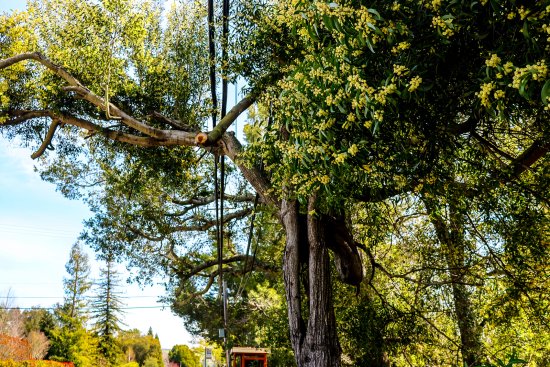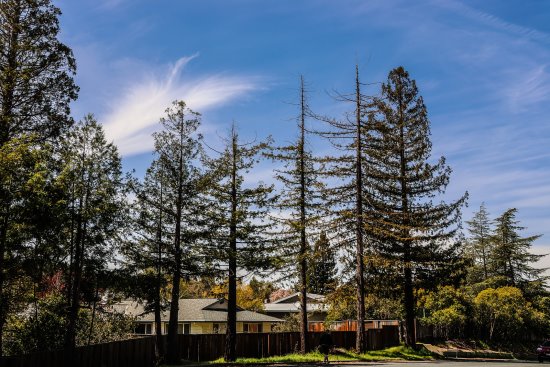| | Published April 12th, 2023
| Winter storms lead residents to wonder about tree safety
| | | By Sora O'Doherty |  | | This huge Acacia tree on Moraga Way has been trimmed, but still interferes with wires above it. The trunk is split and the tree is in poor health. Photo Sora O'Doherty |
After Lamorinda was battered by unusually wet and windy winter storms, Lamorinda residents, as well as governments and utilities, are wondering about the safety of the many trees that grace, and sometimes threaten, Lamorinda neighborhoods. High winds and saturated ground have already claimed many large trees in the area. Assessing trees for potential problems has become paramount. The Lamorinda Weekly spent some time with the president of East Bay Tree Service, Victor Ghavamzadeh, learning about tree assessment.
 Many times a homeowner will notice changes in their tree that make them afraid that the tree has become a danger. Changes might affect the trunk of the tree, there might be discoloration on the bark, or mushrooms growing near the roots. Soil conditions around the tree may have deteriorated, and the tree might be leaning where before it was straight, or leaning more than it did previously.
Many times a homeowner will notice changes in their tree that make them afraid that the tree has become a danger. Changes might affect the trunk of the tree, there might be discoloration on the bark, or mushrooms growing near the roots. Soil conditions around the tree may have deteriorated, and the tree might be leaning where before it was straight, or leaning more than it did previously.
 Ghavamzadeh explained that there are four classifications of tree danger: imminent, probable, possible and un-possible. A tree is an imminent danger if it has failed or is about to fail. This is indicated by the tree being uprooted or if the roots are not holding, or if the tree is suffering bark inclusions, cracks, or splitting.
Ghavamzadeh explained that there are four classifications of tree danger: imminent, probable, possible and un-possible. A tree is an imminent danger if it has failed or is about to fail. This is indicated by the tree being uprooted or if the roots are not holding, or if the tree is suffering bark inclusions, cracks, or splitting.
 Probable danger is indicated if the tree has a good chance of falling, because, for example, it is at a 45-degree angle over a house or has structural defects. In the category of possible danger are trees that are fine now, but might fall in the face of strong winds and extensive rains. But there are also trees that are classified as un-possible, meaning that even high winds and heavy rains are unlikely to damage the tree, often because the tree is small or young.
Probable danger is indicated if the tree has a good chance of falling, because, for example, it is at a 45-degree angle over a house or has structural defects. In the category of possible danger are trees that are fine now, but might fall in the face of strong winds and extensive rains. But there are also trees that are classified as un-possible, meaning that even high winds and heavy rains are unlikely to damage the tree, often because the tree is small or young.
 So what are the warning signs that a homeowner might be alert to? Sometimes a tree divides when growing and develops what are known as predominant and co-dominant leaders, which are weaker than single trunks. In a storm, it is more likely that the co-dominant leader will break away from the tree.
So what are the warning signs that a homeowner might be alert to? Sometimes a tree divides when growing and develops what are known as predominant and co-dominant leaders, which are weaker than single trunks. In a storm, it is more likely that the co-dominant leader will break away from the tree.
 The tree's age is also a factor. Some trees, such as oaks and redwoods, have very long lives, while other trees, such as birch and alder are shorter-lived. The years of drought have also affected trees, causing them to have a less extensive root structure and even adversely affecting the molecular and microbial composition of the soil. Lamorinda has a lot of clay soil, which results in more shallow root structures in trees.
The tree's age is also a factor. Some trees, such as oaks and redwoods, have very long lives, while other trees, such as birch and alder are shorter-lived. The years of drought have also affected trees, causing them to have a less extensive root structure and even adversely affecting the molecular and microbial composition of the soil. Lamorinda has a lot of clay soil, which results in more shallow root structures in trees.
 Another thing that Ghavamzadeh says affect trees negatively is poor pruning, often by people with little training or experience. For example, he pointed to the practice known as "lion-tailing," in which the limbs of a tree, often a heritage oak tree, are cleared of foliage from the center of the tree outward, leaving a tuft of leaves at the very end, resembling a lion's tail. This practice encourages trees to grow further and further out, and eventually branches will fall. This type of pruning error cannot be easily corrected and may cause the loss of trees that are 300 to 400 years old.
Another thing that Ghavamzadeh says affect trees negatively is poor pruning, often by people with little training or experience. For example, he pointed to the practice known as "lion-tailing," in which the limbs of a tree, often a heritage oak tree, are cleared of foliage from the center of the tree outward, leaving a tuft of leaves at the very end, resembling a lion's tail. This practice encourages trees to grow further and further out, and eventually branches will fall. This type of pruning error cannot be easily corrected and may cause the loss of trees that are 300 to 400 years old.
 Many trees fell in the winter storms this year across Lamorinda. One thing that readers might not be aware of, Ghavamzadeh says, is that the state of California actively promoted the planting of Monterey pine trees in Lamorinda to help stabilize the hillsides. The Monterey pine seemed to be a good choice because it tolerated clay soils, which are prevalent in Lamorinda. But drought, insect infestations, and fungus have taken a toll on the trees, which have a much shorter life span than other local trees such as redwoods and oaks.
Many trees fell in the winter storms this year across Lamorinda. One thing that readers might not be aware of, Ghavamzadeh says, is that the state of California actively promoted the planting of Monterey pine trees in Lamorinda to help stabilize the hillsides. The Monterey pine seemed to be a good choice because it tolerated clay soils, which are prevalent in Lamorinda. But drought, insect infestations, and fungus have taken a toll on the trees, which have a much shorter life span than other local trees such as redwoods and oaks.
 Public organizations, such as the East Bay Municipal Utility District and the East Bay Regional Park District have been attempting to remove thousands of dead trees on lands that they own to reduce the risk of fire. Last year Marcus Wagner, Caltrans public information officer, spoke to Lamorinda Weekly about the removal of dead and dying trees along Highway 24. He said that the increase in tree mortality was most likely due to stress brought about by several years of severe drought and invasive pests such as bark beetles. Dead or dying "red-needle" trees are of concern as the needles can become flying embers and help create the conditions for rapid wildfire spread. In their weakened condition, these trees could also possibly fall and obstruct portions of the roadway.
Public organizations, such as the East Bay Municipal Utility District and the East Bay Regional Park District have been attempting to remove thousands of dead trees on lands that they own to reduce the risk of fire. Last year Marcus Wagner, Caltrans public information officer, spoke to Lamorinda Weekly about the removal of dead and dying trees along Highway 24. He said that the increase in tree mortality was most likely due to stress brought about by several years of severe drought and invasive pests such as bark beetles. Dead or dying "red-needle" trees are of concern as the needles can become flying embers and help create the conditions for rapid wildfire spread. In their weakened condition, these trees could also possibly fall and obstruct portions of the roadway.
 Traverso Tree Service in Martinez offers this advice on monitoring the health of your tree: "The best way to care for your pine is to look up. Make it a habit to look up and observe the whole tree and especially its top. If your pine is starting to decline, the top is generally where it will start."
Traverso Tree Service in Martinez offers this advice on monitoring the health of your tree: "The best way to care for your pine is to look up. Make it a habit to look up and observe the whole tree and especially its top. If your pine is starting to decline, the top is generally where it will start." |
 | | | | | | | | | | | | |





